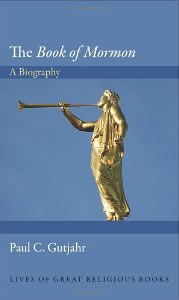Book Notes
 Paul C. Gutjahr, The Book of Mormon, A Biography (Princeton: Princeton University Press, 2012), 255pp.
Paul C. Gutjahr, The Book of Mormon, A Biography (Princeton: Princeton University Press, 2012), 255pp.
This volume is the newest installment in a series of twenty-one "biographies" of great religious books by Princeton University Press. The "Lives of Great Religious Books" is a "series of short volumes that recount the complex and fascinating histories of important religious texts from around the world" (dust jacket). The volumes pair leading experts with classic texts and are written for a general audience. In earlier reviews for Journey with Jesus I've covered Augustine's "Confessions" by Garry Wills and Dietrich Bonhoeffer's "Letters and Papers From Prison" by Martin Marty.
Ever since Joseph Smith unearthed golden plates in upstate New York in 1827, and translated their "Reformed Egyptian" writing into a book, the Book of Mormon and its prophet have been clouded by controversies. The book purports to give a history of our ancient American ancestors from about 2500 BCE to 400 CE. Further revelations about a plurality of gods and wives, a divine curse on blacks that prohibited them from the priesthood (renounced in 1978), and baptism for the dead didn't help their cause. Neither did Smith's thirty wives, his murder while he was in jail, and subsequent splintering into seventy sects (fifty of which still survive).
Paul Gutjahr examines the Book of Mormon with critical rigor and genuine empathy. He doesn't shy away from the hard questions and quirky history. He shows that there are two broad ways to look at these controversies. The first view sets the bar quite high. Many important Mormons have insisted that the truth of their faith rests with the truth of their scripture. Said Orson Pratt, one of the earliest and greatest apologists for the Book of Mormon, "This book must be either true or false. If true, it is one of the most important messages ever sent from God to man. If false, it is one of the most cunning, wicked, bold, deep-laid impositions ever palmed upon the world, calculated to deceive and ruin millions who will receive it as the word of God." Gutjahr's evenhanded treatment allows readers to decide for themselves.
But as he also points out, there's a second way to look at the Book of Mormon. In a sense, the many controversies and criticisms are a mute point point given the remarkable success of the movement. Today the Book of Mormon is available in 109 languages and can be read by ninety per cent of the world's population. There are 150 million copies in print. The LDS boasts 14 million members, with 52,000 missionaries in 160 countries. Later chapters show how the book has burst its narrow religious boundaries to enjoy a vigorous life in the broader culture of stage and screen. The 2011 Broadway musical The Book of Mormon won nine Tony Awards. This much is beyond dispute — the Book of Mormon is one of the most important religious books in American history, and so it takes its rightful place in Princeton's ongoing series.


